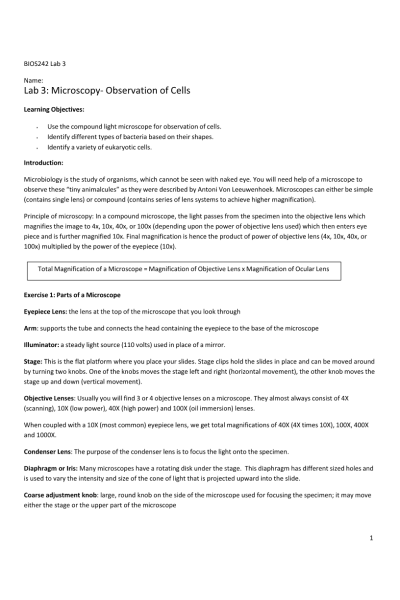BIOS 242 Week 2 Lab 1; Microscopy
-
$20.00
| Institution | BIOS 242 Fundamentals of Microbiology with Lab - Chamberlain |
| Contributor | Anika Fultz |
Lab 3: Microscopy- Observation of Cells
Learning Objectives:
- Use the compound light microscope for observation of cells.
- Identify different types of bacteria based on their shapes.
- Identify a variety of eukaryotic cells.
Introduction:
Exercise 2: Observation of Different Types of Bacteria Materials:
Compound microscope, immersion oil, lens wipes, prepared slides of various bacteria- Rods, cocci and spiral
Method:
- Obtain the preserved slide of a bacteria.
- Use Appendix A and follow the instructions on how to use a Microscope.
- Observe the slide under 10X, and then 40X objective lenses.
- Record and describe your observations made using 40X lens.
- Make sure to note as many details as possible about the size, shape and color (stain) of bacteria.
- Use 100X oil immersion lens if needed and record your observations.
Note to Students: Don’t forget to use oil with 100X lens only. After completing the observation, clean the oil immersion lens with lens wipes to remove oil. Be careful to not contaminate other lenses (4X, 10X, 40X) with oil as this will cause damage to the other lenses.
- Repeat the steps 1-6 for slides containing bacteria of different shapes as needed. Record your observations in the lab report.
Exercise 3:
Observation of Eukaryotic Cells- Protozoa and Fungi
Materials:
Compound Microscope, prepared slides of Protozoa and fungus
Method:
Protozoa:
- Obtain the preserved slide of a protozoa.
- Use Appendix A and follow instructions on how to use a Microscope.
- Observe the slide using 10X, and 40X objective lenses.
- Record and describe your observations made using 40X in the Lab report. Make sure to note as many details as possible about the size, shape and color (stain) of protozoa.
Fungi:
- Obtain the preserved slide of a multicellular fungi.
- Use Appendix A to follow instructions on using a Microscope.
- Observe the slide using 10X, and 40X objective lenses.
- Record and describe your observations made using 40X in the Lab report. Make sure to note as many details as possible about the size, shape and color (stain) of fungus.
Lab 3 Report: Microscopy
Exercise 1: Parts of Microscope
Table 1: Calculate the total magnification
Label the parts of Microscope:
Questions:
Calculate the final magnification:
- 20x objective and 10x eye piece
- 50 x objective and 15x eye piece
Exercise 2: Observe different Types of bacteria
Draw the observation inside the circles provided. Label your image appropriately. Write the magnification at which the observation was made.
Bacterial Slide of:
Questions:
- What three bacterial shapes did you observe?
- How does increased magnigication affect the field of vision?
- Why is the oil immersion objective necessary to determine the morphology of prokaryotes?
- Why is it desirable that microscope objectives be parfocal?
- Which objective focuses closest to the slide when it is in focus?
- Which controls on the microscope affect the amount of light reaching the ocular lens?
Exercise 3: Observe different types of Eukaryotes- Protozoa and Fungi
Draw the observation inside the circles provided. Label your image appropriately. Write the magnification at which the observation was made.
Eukaryotic Slide of:
Eukaryotic Slide of: __
Questions:
- Did you need oil immersion to observe the shape of eukaryotes? Why or why not?
- Describe some of the visual differences you observed between bacteria and Eukaryotic cells.
- CLINICAL APPLICATION: What is the importance of flushing eye wash stations frequently?
| Instituition / Term | |
| Term | Uploaded 2023 |
| Institution | BIOS 242 Fundamentals of Microbiology with Lab - Chamberlain |
| Contributor | Anika Fultz |















































